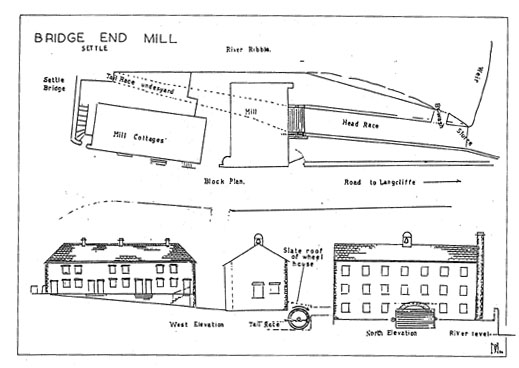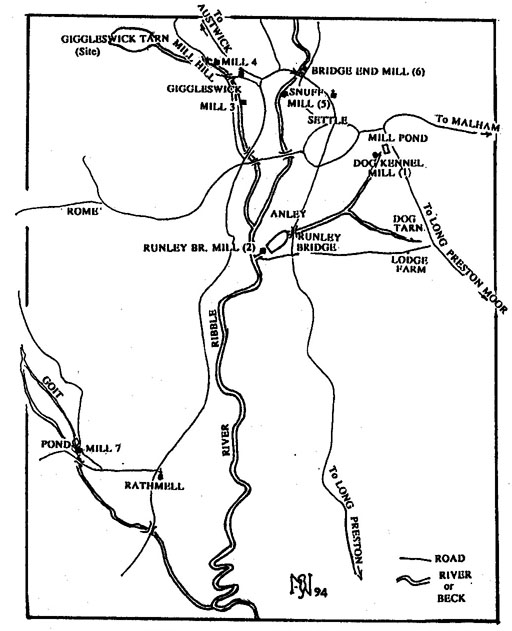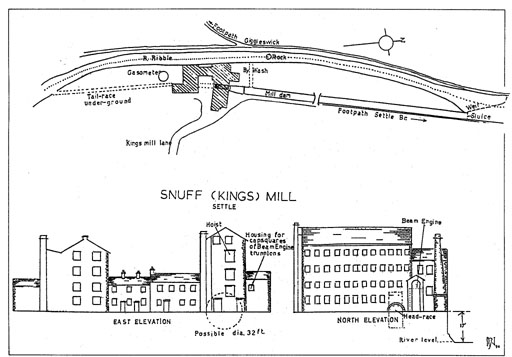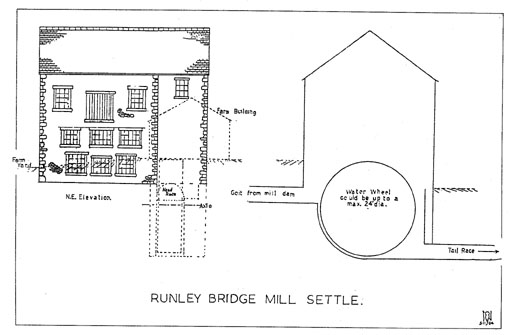| JOURNAL 1994 |
| North Craven Heritage Trust |
I used to look from our home to an unusually large wall in the corner of a field on the hillside opposite. Eventually I found a former window opening in the wall which was the remains of an old water-mill and this started research into "The Water Mills of Ribblesdale". The ordnance survey map of 1847 named it, "Dog Kennel Mill" (1) and its use as cotton. The picture became complete, the mill pond at the top of the bank, a spring at the end of Rope Walk, a goit across Meal Bank to collect Springfield water, and Dog Tarn at the top of the hill. This was an old Settle cotton mill. One day after heavy rain there was the sound of rushing water by the wallside and lifting up a flagstone I found the old mill tail race still serving to drain away the surplus water. The mill became disused and Settle required a reservoir, so the mill pond was used for this purpose. Mill history really starts at Runley Bridge Mill (2). The manor corn mill where daily bread came from, is not only mill history but Settle History. In the domes-day book (1086) there is an entry under "Lands of the King.. .Soke Anleie two carucates". This refers to the mill on land that had previously belonged to the crown and had been taken over by the conqueror. Another entry was "Manor in Anele Setel (Settle), Bu three carucates for tax". Bu was the Lord of the manor under the Norman overlord Rodger-de-Porrou, the carucate being the amount of land that could be ploughed with one plough and soke or stoke being the corn mill system by which the miller took a quantity of grain in payment for grinding. There is no mention of Cleatop or Merebeck so perhaps Anley land extended to Long Preston. By this time the mill was out of action and perhaps the Settle corn was being ground at the Giggleswick mill, said to be on the River Ribble below Queens Rock.
The next we know about Anley or Runley Bridge mill (2) is some 150 years later when Richard-de-Percy then of Cleatop had the mill in action and disputes arose with Elias of Giggleswick, the court records provided us with both mill and Settle/Giggleswick history of the middle ages.
The Giggleswick corn mill (3), driven by Temes beck which was fed by water from the tarn below Huntworth, moved to Mill Hill (4). By 1265 the Percys of Cleatop became lords of both Settle and Giggleswick and the mill disputes ended. Trouble was later to come with the growing Settle market when packhorses brought grain from Knaresborough which was superior to local grown grain. It was sought after by pub landlords for local ale. A horse mill was set up by Wm. Foster in opposition to the monopoly of the manor mill, the income of which was in effect a local tax. In 1620 Runley Bridge mill (2) was extended enclosing the wheel and adding another grinding bay, the remains of the wheel pit and the extension can still be seen. By 1720 the horse mill was closed and although a new market charter made a toll on all imported grain the days of the manor corn mill were numbered. Cotton was being imported into Liverpool and transported on the canal, and the turnpike road of 1753 provided access for horse waggons to bring raw cotton. The Runley Bridge mill (2) was advertised in 1784 as "well situated for spinning cotton wool or flax". Jas. Brenard managed it from 1788-1793 followed by Thornber & Co. who also had the higher mill in Settle, Dog Kennel Mill (1). About 1803 both these mills were let to Messrs Proctor who owned the Snuff mill with the new cotton factory added, retaining a wheel for grinding for some time. Proctors continued with Runley Bridge mill (2) until it was destroyed by fire 25 August 1825 although still on O.S. Map of 1845 as a cotton mill. About 1847 the floors were taken out and the building turned into a hay barn. A bank by the farm yard is all that remains of the dam, the mill pond would extend as far as the bridge on the turnpike road.
Kings Mill Settle, (Snuff mill) (5) owned by Thornber & Co. and let to Thos. Proctor & Son, was powered by water, the weir being just below Settle Bridge, with the mill dam running by the bridge to the mill footpath, creating a mill island (now the council yard). There is a reference to these facts in a will of 1844 along with 30 cottages. The arch of the head race can be seen in the north wall of the present mill, no doubt with an external wheel which would have been enclosed with the building of the cotton factory. The oldest part is by the river known as "t'Old snuff. The height between the head race and tail race is over 20 feet so the wheel could have been any diameter up to 40 feet but no trace of the wheel pit can be found in the present mill. Remains of a building on the north side is where a beam engine was installed, the boilers being at the NE corner of the mill. A fire destroyed the mill in July 1837, but it was soon back in action again, with its own gas works sited at the south end. Most of the cotton processing in Ribblesdale was spinning, but weaving was done at Kings Mill, which closed down before World War I.
The Albert Hill mill situated just below the old Catholic Church on the upper Malham road could not have had any water power, it may have been a fulling or hand weaving mill. Reference in 1837 to an upper Settle mill is to Dog Kennel Mill (1) and Thos Brenard, spinner, Scaleber Cottage (the mill cottage).
Bridge End Mill (6) (marked on O.S. Map 1847 Cotton) was the last of the North Ribblesdale mills to have a working wheel. The date over the tail race arch has now been washed away but it predates working people owning clocks. A bell tower on the roof tolled the time for work. Much of the shell remains along the wheel, and part of the dam and by-wash are visible from the Langcliffe road. The weir and tailrace can be seen from the bridge. In the early days of the cotton industry Liverpool docks imported raw cotton which was then transported on the canal. Any good river or beck could provide power to turn the spindles of the mill wheels. Water power at Settle Bridge resulted in another cotton factory being built. Just how long it was in production is not clear. When Messrs Brassington were looking for a saw mill the building at Bridge End was derelict and Hector Christie let it at a peppercorn rent. It required renovation and wood working machinery was installed powered by water. Work produced there is admired to this day by the many visitors to churches of the district including Giggles wick School Chapel. Much of the Church furniture was made from imported cedar cut by a horizontal saw powered by water. For the greater part of the year water supply was adequate but in a dry summer extra water was directed into the dam by raising the weir edge with boards. Now the mill is a block of flats, the wheel is still there and can be turned by water. However, the transmission shaft with its bevel gear is disconnected so that last of the working water mills is left for the imagination to fill in the details.
Documentary evidence about the water mill at Rathmell (7) goes back to 1792 when an advert appeared on 27 November in the Blackburn Mail offering "a water powered cotton mill complete with machinery, all in good working order". Many of the dales cotton mills were originally the old manor corn mill, but in the case of Rathmell, the corn grinding came after the cotton, with the mill stone bearing the date 1811, all powered by a 17 foot diameter external overshot wheel, mounted by the south gable of what was then a four-storey building. Change came again in 1866 when the present Mr Mansergh's grandfather bought the mill complete with pond and goit, to convert into a saw mill. Large trees from the local woodland were reduced to planks of required thickness, hard and soft woods for farm carts, ash, oak and elm for the wheelwright. Hooping was done on what had been the grinding wheel of the corn mill. The whole assembly of machines were motivated by water. When the days of the water wheel came to an end a turbine was installed and with the great height that was available, a 10" feed pipe generated 8 horsepower. The year 1925 saw a great change at Rathmell with the introduction of hydroelectricity. There was no more fire hazard of candles and oil lamps amongst highly inflammable wood. Not only that, Manserghs and Garnetts had electric light and were the envy of the whole village.
Now after a history of over 200 years, the goit is silted up and grown over, the mill dam is filled in and a house built on it. The mill itself still stands on the steep bank of that beauty spot of the parish.
The author wishes to thank the many generous people who have given him information for this article.
Jim Nelson. Illustrated by the author.

BRIDGE END MILL SETTLE

Mills referred to in the text. wood.

SNUFF (KINGS) MILL
